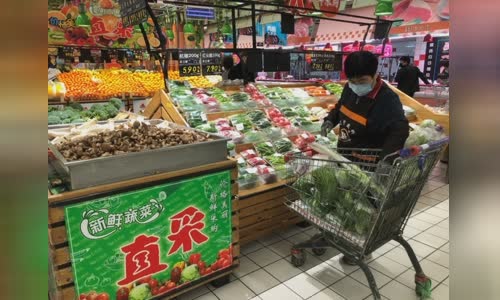China establishes a "green flow" and takes advantage of technology to market and distribute agricultural products, helping to solve the problem of congestion in the epidemic.
When Covid-19 strongly spread in China in the early months of 2020, the country imposed many measures to blockade and restrict the movement of people, causing the supply chain of agricultural products to suffer.

A person goes to a supermarket in China in early 2020 Photo: FAO
A series of measures have been taken to address the problem.
The China Quality Agricultural Service and Development Association initiates an alliance with the participation of businesses such as Pinduoduo (a platform that connects farmers with distributors and customers) with guidance from Wuchang.
Information and communication technology is utilized.
Another important platform is the Poor Area Agricultural Products Online Selling Platform, set up by the Ministry of Finance and the Poverty Reduction Division of the State Council of China, which focuses on supporting disadvantaged regions.
Locally, provincial and city governments have also set up online platforms to facilitate transactions, such as the Beijing Agricultural Supply-Demand Platform.
The Chinese government also encourages e-commerce businesses to actively participate in selling agricultural products, taking advantage of their experience and resources.
To drive sales, the platforms establish special sales portals with beautifully designed graphics and slogans such as "care for the farmer", and offer coupons and discounts to
They also use marketing tools like live broadcasts and short videos like TikTok, in which online celebrities showcase the good qualities of agricultural produce.
A live broadcast of Wuhan tea helped them sell 0.89 million yuan ($ 130,000) worth of merchandise while it went live and a million yuan ($ 140,000) later.
Alibaba set up a one billion yuan ($ 141 million) fund to support farmers and sold 118,000 tons of agricultural products that stagnated in less than 40 days.
To ensure smooth cargo, China has established a "green channel", which allows vehicles carrying agricultural products to pass through a screening station or toll booth using a passport issued by the provincial government.
In January 2020, the State Tax Bureau of China announced that any income from transporting critical commodities during the crisis, including agricultural products, would be exempt from value added tax.
E-commerce businesses also introduced logistics innovations such as providing contactless delivery by installing shelves, setting up a service point in a residential area, and delivering to several locations.
To avoid shortages of delivery personnel, a "labor sharing" model was created, mobilizing "idle" employees in other areas such as catering and retail to temporarily work for an e-commerce company.
"Mixed stores" and "general pick-up points" are rolled out in a number of cities.
A "group buy" model was also created to simplify deliveries, save labor and reduce exposure.
Food and Agriculture Organization of the United Nations (FAO) assesses that there are some lessons learned from the Chinese approach that the need for cooperation and coordination of many stakeholders at different levels and diversity of channels.



 Becky Johnson
Becky Johnson







